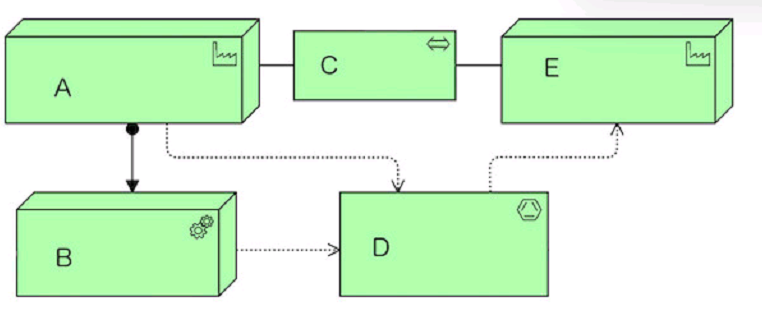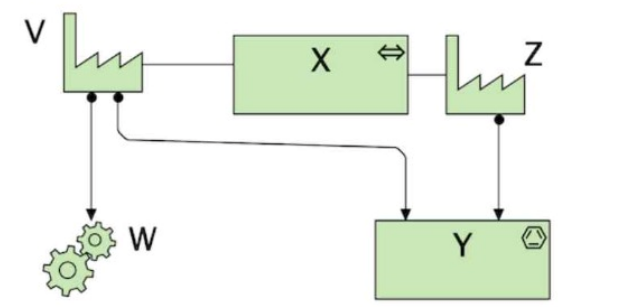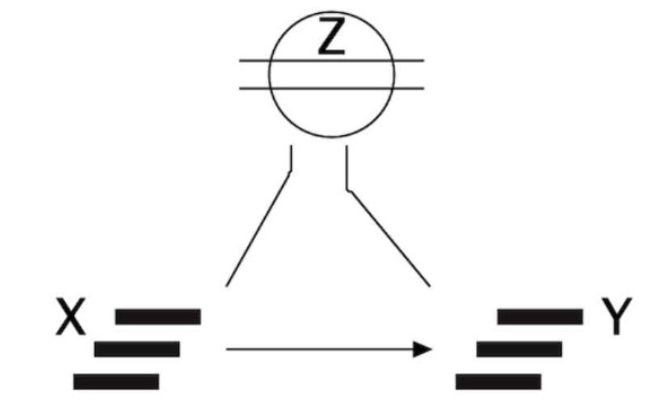The Open Group ArchiMate 3 Part 1 OGA-031 Exam Practice Test
Consider the following diagram:

What are elements A, B, and C?
Answer : D
The diagram uses the ArchiMate notation for physical elements, which are used to model physical concepts like machines, physical installations, materials, and distribution networks. A is an equipment element, which represents a physical machine, tool, or instrument that can create, use, store, move, or transform materials. B is a material element, which represents tangible physical matter or energy. C is a distribution network element, which represents a physical network used to transport materials or energy.
What relationship is allowed from a technology function to an application function?
Consider the diagram:

(A diagram showing V, W, X, and Y where:
V has a factory-like symbol.
W has a gear-like symbol.
X is connected to Y, which has a transportation-related symbol.)
What are elements V, W, and X?
Answer : D
Comprehensive and Detailed In-Depth
This ArchiMate Physical Layer diagram represents logistics and supply chain operations. The elements in the diagram align with physical infrastructure concepts used in ArchiMate 3.2.
Understanding the Diagram Elements:
V (Factory symbol) Represents a Factory or Production Facility, where goods are manufactured.
W (Gear symbol) Represents Raw Material or Equipment that is used in production.
X (Network or Transportation symbol) Represents Transportation or a Distribution network for moving goods.
Y (End-point receiving goods) Represents a logistics center, warehouse, or transportation endpoint.
This matches option D, where:
V = Factory The starting point of manufacturing.
W = Raw material Essential input for production.
X = Transportation Moving products to distribution centers.
Analysis of Answer Choices:
A. V = Production process, W = Finished Material, X = Transport network Incorrect
V is not a process; it is a physical location (Factory).
W represents raw material, not finished material.
X represents transportation, but V is wrongly classified as a process.
B. V = Equipment, W = Facility, X = Distribution channel Incorrect
V represents a Facility (Factory), not just Equipment.
W represents raw material, not a Facility.
X is more of a transportation network rather than a distribution channel.
C. V = Facility, W = Equipment, X = Distribution network Incorrect
W represents raw material, not just Equipment.
X represents Transportation, not strictly a distribution network.
D. V = Factory, W = Raw material, X = Transportation Correct Answer
This is the best match with the diagram's physical elements.
V (Factory) is the production source.
W (Raw material) is used in production.
X (Transportation) is the means of moving goods.
ArchiMate 3.2 Specification, Section 7.7, defines Facilities, Materials, and Transportation as part of the Physical Layer modeling concepts.
Final Answer: D. V = Factory, W = Raw material, X = Transportation.
ArchiMate 3.2 Specification: Sections 7.7 (Facilities & Physical Elements), 7.8 (Material Flow), and 7.9 (Distribution & Logistics).
Consider the diagram which has color removed from it:

(A diagram showing two stacked horizontal bars labeled X and Y, connected by an arrow, and a circle with lines (Z) positioned between them.)
What is the correct description of this diagram?
Answer : B
Comprehensive and Detailed In-Depth
This ArchiMate Implementation & Migration Layer diagram represents an architecture evolution model, specifically showing two plateaus (X and Y) with a Gap (Z) in between them.
Plateaus in ArchiMate represent states of an enterprise architecture at different points in time.
Gaps represent the difference or missing elements between two architectural states, indicating what needs to change.
The circle with lines (Z) represents a Gap, which identifies what is missing or needs to be addressed when transitioning from Plateau X to Plateau Y.
Analysis of Answer Choices:
A. Two plateaus (X and Y) with a transition architecture (Z). Incorrect
A transition architecture is different from a gap.
A Transition Architecture provides an intermediate step between two plateaus, whereas this diagram is identifying a Gap between them.
ArchiMate 3.2 Specification, Section 7.4.3, defines Gaps as structural differences, not transition states.
B. A gap (Z) associated with two plateaus (X and Y). Correct Answer
The circle with lines (Z) is the correct representation of a Gap in ArchiMate.
Plateau X represents the 'Before' state, and Plateau Y represents the 'Target' state.
Z (Gap) represents what is missing or what must be addressed to move from X to Y.
ArchiMate 3.2 Specification, Section 7.4.3, states that Gaps are used in architecture migration to analyze missing capabilities or elements.
C. A deliverable (Z) exchanged between two projects (X and Y). Incorrect
A deliverable is typically represented as a document or artifact in ArchiMate, not as a Gap.
Z represents a missing element between states, not an exchanged deliverable.
D. Two nodes (X and Y) connected by a communication path (Z). Incorrect
Nodes and Communication Paths belong to the Technology Layer, but this diagram represents the Implementation & Migration Layer.
X and Y are plateaus, not technology nodes.
Final Answer: B. A gap (Z) associated with two plateaus (X and Y).
ArchiMate 3.2 Specification: Sections 7.4.1 (Plateau) and 7.4.3 (Gap).
Archi User Guide: Modeling architecture migration using Gaps and Plateaus.
In the Business Layer metamodel, what type of element is assigned to a Business Service?
Answer : C
Comprehensive and Detailed in Depth
A Business Interface is an external active structure element that provides an external point of access to one or more Business Services. In the Business Layer metamodel, a Business Service is assigned to a Business Interface because interfaces define how services are exposed to external parties or other components within an enterprise.
This is confirmed in the ArchiMate Specification 3.2, where a Business Interface is described as representing a point of interaction that enables access to Business Services.
Archi User Guide
Complete the sentence. The ''Course of Action" element is used to represent __.
Answer : D
Comprehensive and Detailed in Depth
The Course of Action element represents what an enterprise has decided to do in order to achieve a strategic objective. It defines high-level actions and strategies that guide business capabilities and activities.
The ArchiMate 3.2 Specification states that Courses of Action define the high-level choices and strategic actions taken by an organization.
Archi User Guide
ArchiMate 3.2 Specification
Relationships are classified in a number of categories as shown below What are A, B and C?
Answer : D
This is because the diagram shows the three main categories of relationships in ArchiMate: structural relationships, which model the static construction or composition of concepts; dependency relationships, which model how elements depend on or use other elements; and dynamic relationships, which model the temporal or causal connections between elements.